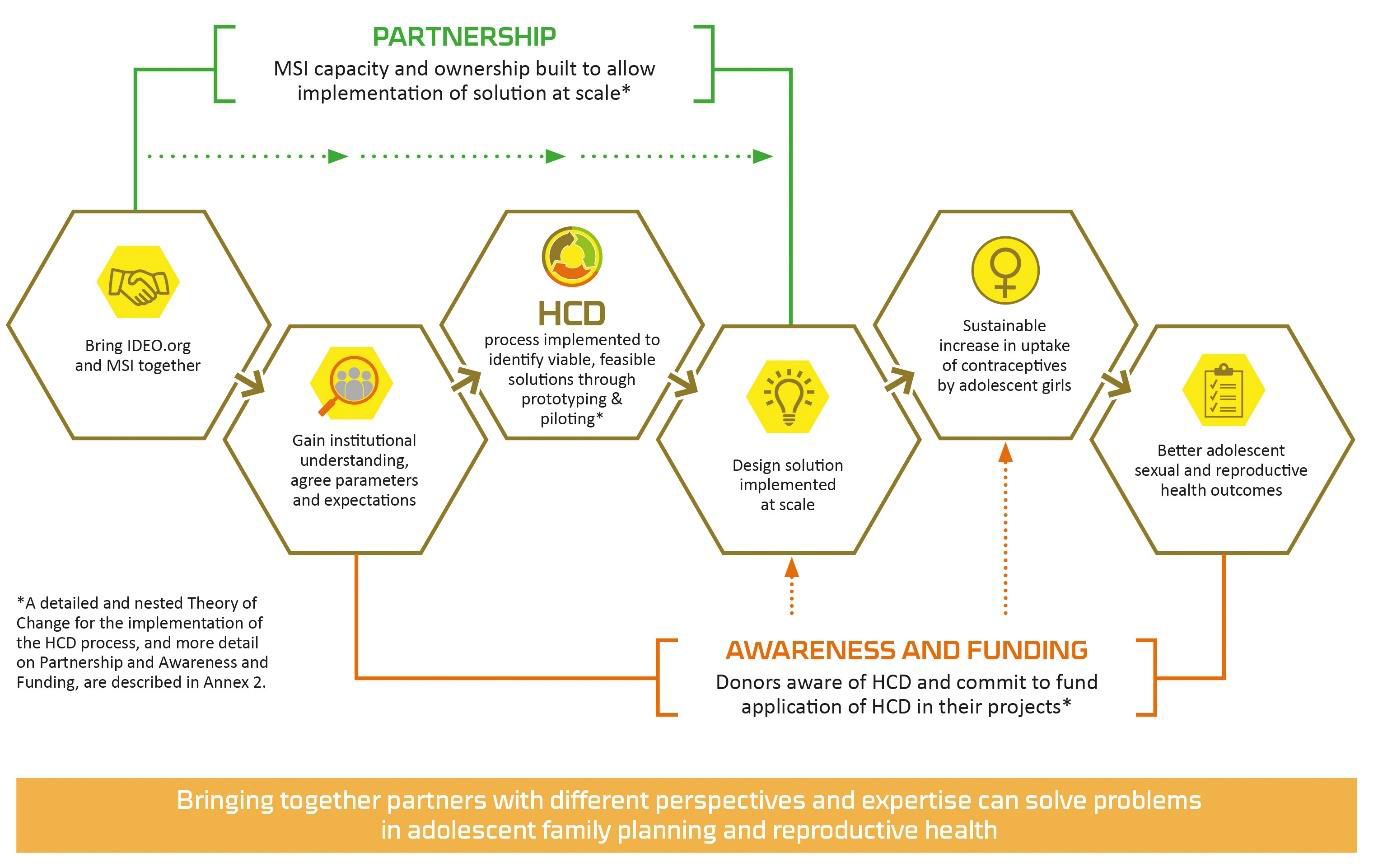Since 2013, the Hewlett Foundation (the Foundation) has supported IDEO.org and Marie Stopes International (MSI) to apply Human-Centred Design (HCD) to improve family planning (FP) and reproductive health (RH) services for adolescent girls in sub-Saharan Africa.
HCD, as practised in this programme by IDEO.org, is a structured process to identify solutions that are desirable to an identified target population, and viable and feasible for the client. This is done through iteratively building and testing solutions through the use of prototypes that are adapted based on users’ feedback (rather than primarily on experts’ understanding of the needs of the target group). HCD includes three distinct and separate components: inspiration, ideation and implementation.
The evaluation
Over the course of 2016 and 2017, Itad conducted an independent evaluation of the programmes in Zambia and Kenya. The evaluation is grounded in testing the Theory of Change (co-created with the Foundation, IDEO.org and MSI) behind using HCD to improve FP/RH services for adolescent girls in sub-Saharan Africa and answering the associated top-level, framing evaluation questions:
- Does HCD work and why?
- What external and internal factors affect its uptake and success?
The findings
1. Does HCD work and why?
HCD-designed solutions have increased uptake of FP/RH services by adolescents, and results are better compared with MSI’s previous adolescent programing. However, it is too early to conclude whether the solutions can be scaled and sustained.
2. What external and internal factors affect its uptake and success?
- Partnership: Commitment to stay the course. A strong and committed partnership has enabled Hewlett, IDEO.org and MSI to tackle a range of challenges during the HCD process in both Zambia and Kenya.
- Solutions-related Factors: There is emerging evidence of success in increasing FP/RH service uptake by adolescents. Early technical concerns with the HCD-designed solutions (around reaching target audiences and how innovative the solutions were) affected perceptions of the success of HCD. Many of these perceptions can be linked back to divergent expectations, in particular those concerning scalability and sustainability.
- HCD-related Factors: All HCD components are necessary for getting a solution ‘out there in the world’, but ideation appears to have the most value in that it starkly differentiates HCD from more traditional developmental approaches to design. Sufficient time and resources for preparation appear to be very important in terms of providing the foundation for success. Empathy, iterating and learning are the design mindsets most valued by MSI.
What does this mean going forward?
Institutionalisation in MSI: Efforts to build HCD capacity in MSI have been slow to start and learning is consequently limited. Nevertheless, it is possible to identify areas where HCD adds value, and where MSI is lacking capability and systems to ‘do HCD’; this could help MSI institutionalise the process.
Applying HCD in Other Contexts: The extent to which HCD as implemented by IDEO.org holds promise in other sectors and for other donors is linked to its ability to deliver results, and, in spite of relatively little data on impact, HCD is being funded in various forms by other donors and in other sectors. The conditions that made the FP/RH sector ‘ripe’ for HCD are likely to be present in other sectors. However, the important steps the Foundation, MSI and IDEO.org took to overcome challenges should not be overlooked or minimised.
Recommendations
We have 11 specific recommendations that are derived directly from the main findings and conclusions of the evaluation. By way of overview, these 11 specific recommendations can be grouped into three main related categories: continue and embed; monitor, learn and course correct; and act now.
Our top five recommendations are listed below, for our full recommendations, please see the report or executive summary:
Continue and Embed
- Develop clear guidance for using HCD in partnership settings for use at the start of a new HCD partnership to help explain potential risks and mitigating strategies.
Monitor, Learn and Adapt
- Promote shared understanding that the implementation phase involves iteration and learning, and that undue pressure during piloting could choke innovation and kill ideas with potential.
Act Now
- Pay greater attention in the preparation phase to: 1) establishing clear understanding of innovation appetite and associated risks; 2) developing a shared understanding of goals and what constitutes success, including in relation to considering the questions of sustainability (viability) and scale (feasibility); and 3) clarifying working arrangements.
- Ensure synthesis of insights and the process of prototyping are more inclusive and discursive, explicit and well documented. IDEO.org should complete synthesis in country, together with MSI staff, or find ways to ensure MSI staff are front and centre during ideation.
- At the start of the project, both partners should co-create an M&E strategy that defines outcomes that will be measured during live prototyping, and those that will measure the success of the solution.
To read what the Hewlett Foundation said about the evaluation, click here. For more information on the projects, visit the IDEO.org website.
Read the Full Report.


